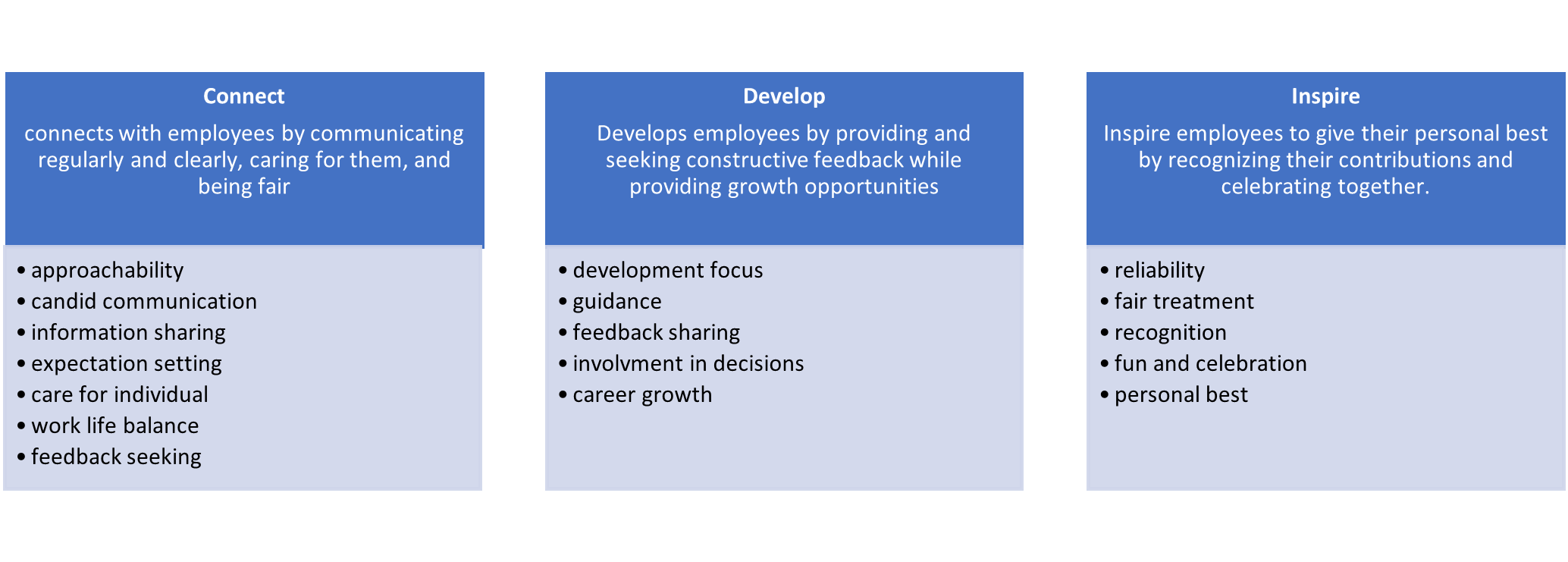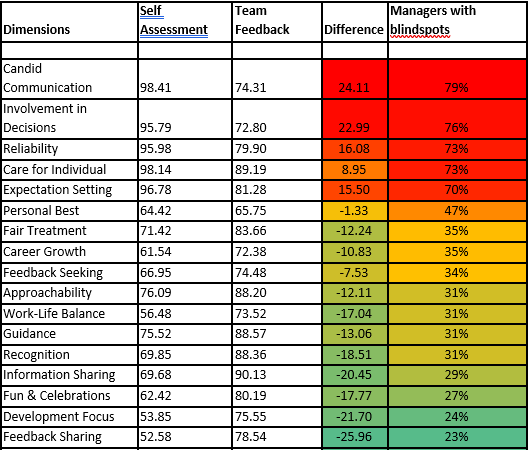Executive Summary
This study was conducted to recognize and understand some of the major blindspots carried by the people managers in India. For this purpose, GMI launched an AI powered self-assessment and team feedback survey and gathered responses from around 4296 people managers and their team members. The data was collected over a period of 6 months. The study reveals that most managers display ‘blindspots’ on critical people management competencies like communicating candidly, involvement in decision making, caring for others, being reliable and setting right expectations.
A staggering gap was found between how people managers see themselves and how their team members perceive them. Recognizing these blind spots is a first and a crucial step towards bridging this gap. Basis this, HR leaders can tailor relevant interventions to build more self-awareness among people managers. Read more to delve deeper.
A leadership blindspot refers to a hidden or unrecognized area of weakness that a leader possesses, which can hamper their ability to make effective decisions or lead their team successfully. Most of the times, leaders are unaware that they are making a mistake, and it is often because of a blind spot. This ‘lack of awareness’ can arise from various factors, including personality traits, biases, or simply lack of experience.
Robert Bruce Shaw has done a comprehensive work on ‘Leadership Blindspots’ and he defines it as an “unrecognized weakness or a threat with the potential to harm a leader and his or her organization”. Weaknesses that we are aware of aren’t likely to derail us from our goals. However, the weaknesses that we have turned blind to are the dangerous ones and need to be recognized and fixed. These blindspots can manifest in many ways such as:
Lack of self-awareness
Some leaders may not recognize their own strengths and weaknesses, leading them to overestimate their abilities or underestimate the impact of their actions on others. It is said that “leadership without self-awareness is like a ship without a compass- destined to drift aimlessly in turbulent waters”.
Tunnel vision
Leaders may focus too narrowly on certain aspects of a problem or situation, ignoring other important factors that could impact their decisions.
Overconfidence or arrogance
A leader’s excessive confidence can prevent them from seeking input from others or considering alternative viewpoints. Other experts of this subject Shaw and Karen Blakeley also found out in their research that one of the most common causes of leadership blind spots is pride bordering arrogance.
Inadequate understanding of the team
Leaders may fail to understand the individual strengths and potential of their team members, which can result in assigning tasks that are not suited to their abilities, resulting in failure.
Identifying Blindspots: Uncovering the unknowns
Identification of blindspots is challenging yet necessary and the good part is, it is possible to do that. It is not a one-time process rather it is an ongoing process which requires leaders to be open-minded and show commitment towards continuous self-improvement. Here are some strategies that can help leaders become more aware of their blindspots
Self- reflection
Encourage your leaders to reflect on their leadership style, behaviour and decision-making process and ask them to create their own Johari window. Johari window is a technique designed to help people better understand their relationship with themselves and others.
Seeking feedback from others
Actively seek feedback from your team members, peers, and superiors. Create an environment where people feel comfortable providing honest and constructive feedback. Anonymous surveys or one-on-one conversations can be effective in gaining insights into areas where your leaders may have blindspots. Once this is done, the responses can be compared against leader’s self-reflection to determine if there’s any misalignment.
Use reliable and valid assessments and tools
Some leadership assessments and tools are designed to identify blindspots. These tools can help you gain insights into your leadership strengths and weaknesses, making it easier to spot areas where your leaders might have blindspots.
Have a diverse network
Being surrounded with people of diverse background will provide a fresh and diverse perspective to the leaders and will help uncover some of their blindspots.
Conduct leadership development interventions
Organize leadership training and development programs that focus on self-awareness and emotional intelligence. These programs can help you uncover blindspots and develop strategies to address them.
Let’s move on to read more about the study participants and methodology of this study.
Study Participants and Methodology
The study saw the participation of 4296 people managers and their team members from various organizations in India. Participants used GMI’s AI-powered people leadership assessment and development platform and completed a self-assessment questionnaire which was then followed by an anonymous team feedback survey (appendix 1). Our approach is inspired by the heuristic exercise created by psychologists Joseph Luft and Harrington Ingham – Johari Window, to help participants (people managers in this case) uncover and understand their leadership blindspots.
Both the self-assessment and the team feedback is based on a psychometrically reliable and valid people leadership assessment instrument that measures managers on 17 dimensions pertaining to people management competencies. These dimensions fall under three broad categories – Connect, Develop & Inspire in a framework. The framework helps in understanding how well do you connect with your team, develop their skills and inspire them to bring out the best in them (figure 1 ).

Findings and Observations
The data (Table 1) reveals that people managers display an optimism bias1 on people management competencies like communicating candidly, involvement in decision making, caring for others, being reliable and setting right expectations. This indicates the presence of some unrecognized weakness which managers aren’t aware of- ‘people managers think they are doing a great job whereas their team members think otherwise. This is certainly an area of concern which need to be addressed.

The heatmap below presents a clear picture of how the team feedback analytics dashboard looks like. The shades of red point to a higher disparity between managers’ self-perception and their team members’ perceptions of various dimensions indicating the presence of leadership blindspots.

As per the data, five major leadership blindspots were identified for the dimensions mentioned below.
- Candid Communication
- Involvement in Decisions
- Reliability
- Care for Individual
- Expectation Setting
Each of these dimensions were found to be significant blindspots for 70% or more than 70% managers. For rest of the dimensions, the trends were reversed where most of the team members rated their managers more favourably. Let’s delve deeper into each of these 5 dimensions and look at some of the ways to fix the gap.
Candid communication
Candid communication is perhaps the most powerful tool used by the leaders as well as team members to exchange views and important information. It plays a pivotal role in fostering a healthy and transparent work environment. It is particularly important for the leaders to communicate regularly, clearly and effectively with their team members – mainly because leaders are seen as the main figure who set standards and expectations, give instructions and guidance to carry out important tasks and take important decisions, impacting the entire team as well as business. A large part of communication is also listening to their team members’ feedback, ideas and concerns.
Present study revealed a substantial difference between the scores of managers and their team members indicating that leaders believe their communication to be very open, inclusive and fair whereas the team members feel otherwise. Absence of candid communication has its own downside and may lead to:
Conflicts
Candid communication helps ironing out differences between leaders and team members. However, absence of open communication would result in misunderstandings and unresolved issues leading to conflicts.
Lack of problem-solving
While open communication enables employees to discuss challenges, bottlenecks, and obstacles without fear of retribution. Absence of it will result in lack of discussions around any challenge or issue amounting to the big problems. Openness in communication allows for collaborative problem-solving, where multiple perspectives and solutions can be considered, leading to better decisions.
Lack of innovation and creativity
When employees feel safe to share their thoughts and ideas openly, it fosters the culture of innovation and creativity. However, when team members do not feel comfortable expressing their thoughts and viewpoints openly, the free flow of ideas get hindered compromising innovation and creativity.
More room for grapevines
In an environment of open communication, there is less room for rumours and gossip to spread. Employees are more likely to rely on accurate information rather than hearsay. However, when communication channels are restricted, team members rely on half-baked information leading to gossips.
To make managers aware of this blindspot, various interventions can be developed such as some programs on improving candid communication which will leave leaders with some food for thought. Managers need to be encouraged to have open dialogues with their team members. Furthermore, creating channels for feedback, such as timely surveys, suggestion boxes, or regular meetings, can also facilitate candid communication among people managers.
Involvement in decisions
When managers involve others in decision-making, it leads to more robust, well-rounded, and inclusive choices, improving the overall effectiveness of an organization. However, not involving others in decision making process is a major blindspot; managers believe that they ‘know all’ and don’t need diverse perspectives to decide upon something. This exclusion of others has its own repercussions like, reduced buy-in and engagement from the team members, higher risk of errors and oversights, missed innovation opportunities and lack of diverse perspectives.
Managers may consciously include others in decision making process; a regular, timely session with team members having varied roles, expertise, and experiences can provide valuable and well-rounded information that those directly involved might miss. This practice will also facilitate a culture of collaboration, transparency, and shared responsibility, essential ingredients of growth and progress.
Reliability
Becoming a more reliable leader is crucial for building trust and credibility among team members and stakeholders. Being reliable means consistently following through the commitments and remain ethical and predictable in actions and decisions. Unfortunately, in the present study, a gap has been found between managers’ and team members’ perceptions which isn’t a good sign. Team members look up to their leaders and want to follow their path, however, in case, team members find their leaders to be inconsistent, their morale and confidence plummet, leading to doubts and uncertainties. Organizations may help leaders by conducting personalized sessions on self-reflection, integrity and trust. This can be followed by a personalized coaching by an expert. By gaining insights and by practising to be consistent, leaders may become more dependable and trustworthy.
Caring for others
Caring for others is a fundamental aspect of leadership that leads to positive outcomes at both individual and organizational levels. A caring leader creates a supportive and empowering environment, where team members can thrive successfully, leading to increased performance and job satisfaction. Caring for others is also closely related to emotional intelligence, another critical leadership skill. It is usually said that leaders with high emotional intelligence can understand and empathize with their team members’ emotions, helping them address challenges and conflicts more effectively.
The data here highlights the gap between managers and team members indicating that team members expect more care and support from their managers while managers believe that they are already providing a good support! Managers are oblivious of the needs of their team members and thus not able to establish that bond!
To address this, managers need to prioritize the well-being of their team members, need to provide guidance, support, and opportunities for learning and advancement. Casual team catch-ups would help managers create that bond with their team members leading to more open and candid conversations. Further, managers may personally chat with a member having issues. Organization may also arrange for some emotional intelligence sessions to encourage managers to be more aware and cater to others’ emotional needs.
Setting expectations
Setting expectations is a foundational, interactive process through which leaders give directions to the team members about the goals to be achieved, Key Result Areas to be met and clarity around what is expected from the team members. Not setting expectations can be a significant leadership blind spot! The present study highlights the fact that leaders think that they have set the expectations right however team members have different opinion regarding the same which may have adverse repercussions. When expectations are not clearly communicated by the leaders, team members may not properly understand what is expected of them. This lack of clarity can lead to confusion and uncertainty about their roles and responsibilities, which can result in suboptimal performance and productivity. It is important that leaders define roles, responsibilities, goals, and performance standards very clearly and keep checking the progress. Communicating these expectations transparently will foster a positive work environment, empower team members, and will have positive impact on the productivity and growth.










